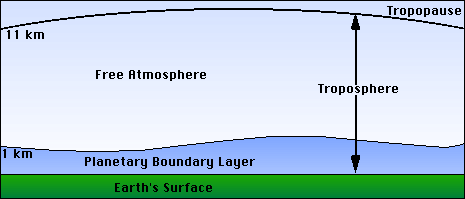|
|
PBL DefinedWe discussed before that friction is generated by the earth's surface, but that aloft friction is negligible in comparison. At some point in the atmosphere, there is a zone where friction goes from significant to insignificant. The lower layer of air which is subjected to turbulent (frictional) processes is known as the planetary boundary layer (PBL). The remaining air in the troposphere is known as the free atmosphere (because it is free of frictional influences.
 But what is a boundary layer? It turns out that there is a well defined, but quite variable height, where the influence of friction stops. Below this point, the earth's surface has direct influences on motion in the atmosphere. These influences include frictional drag, evapotranspiration, terrain induced flow modification, heat and energy transfer, and pollution emission. The PBL is that layer which is influenced directly by the earth's surface. Much of the weather we feel and see is a result of changes in the PBL. It is the layer that dissipates the energy from the upper atmosphere. Geostrophic winds above the PBL are often greater then 50 kts (58 mph). If those winds were prevalent at the earth's surface, it would be like having a tropical storm everywhere. Through friction and turbulence in the PBL, the energy in the free atmosphere is dissipated throughout the PBL. Below is a comparison of characteristics between the PBL and the free atmosphere. Next, we look at the structure of the PBL.
A site that shows PBL heights (using the MM5 model) is Penn State's Meteorology site. It is instructive to look at the variations in PBL height at various times of the day and over various days. Confused? Have a question? If so, check out the Frequently Asked Questions (FAQ) page or send mail to the OS411 tutor (os411tutor@shodor.org) with your question! Report technical/content problems here |
|
|